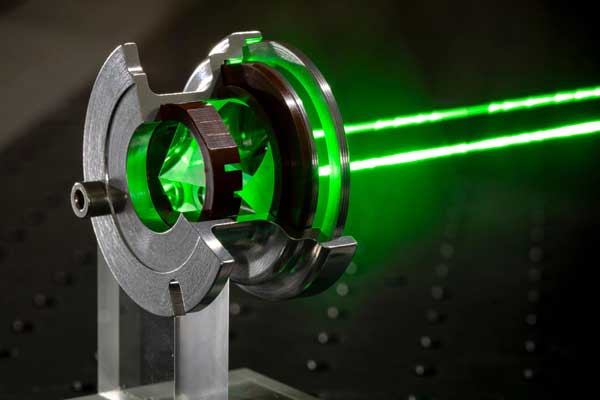
- The DLR Institute of Technical Physics has developed a new generation of laser reflectors for satellites.
- Satellites equipped with the reflectors should be able to be located with centimeter precision using lasers and at the same time be clearly identified.
- The reflectors have additional optics for polarizing the laser light for the satellite laser ranging process.
- Focus: space travel, security
COLOGNE, Germany (DLR PR) — The German Aerospace Center (DLR) is testing a new generation of laser reflectors for satellites. Satellites equipped with it should be able to be located from Earth with lasers and identified at the same time. The special thing about the new reflectors is the adjustable polarization optics for each satellite. These individually change the properties of a reflected laser beam, which allows the satellites to be distinguished.
The method is intended to support radar measurements of satellite orbits in comprehensive space traffic management. Evasive maneuvers can thus be carried out more efficiently in order to avoid collisions with space debris or other satellites. This helps to save fuel and thus extend the service life of satellites. Another advantage of laser reflectors is that they work without electricity. This means that obsolete or defective satellites can also be identified.
Polarization of laser light helps distinguish satellites
The measurement principle is based on the established satellite laser ranging method: the reflectors attached to the outside of the satellite reflect the laser beam from a ground station back to it. “The laser pulses only need a few milliseconds to travel between the station and the satellite. By measuring several of these time intervals, we can determine the orbit of the satellite to within a few centimetres,” explains Dr. Nils Bartels from the DLR Institute for Technical Physics .
The new mirror optics have a diameter of around one centimeter and weigh a few grams. So-called polarization optics are attached in front of the mirror prisms of the reflectors. These rotate the polarization of the reflected laser light, i.e. its electromagnetic oscillation level. “Individually adjusted reflectors produce a characteristic polarization of the laser reflections. This can be used like a code,” explains Bartels. “This consists of a sequence of several laser pulses with different polarization. By measuring the respective change in polarization for each satellite, the satellites can be distinguished – like a license plate.”
The challenge is to measure the reflected laser pulses. Only a few laser photons come back to the ground station as a code that can be evaluated. The DLR Institute of Technical Physics is testing highly sensitive measurement techniques to count the individual photons and determine their polarization.
The next step leads into space
So far, the DLR researchers have tested the technology in the laboratory. They have already tested the laser reflectors for use in space. These include, for example, the diffraction effects at the edges of the optics. These are expansions of the laser beam over large distances, which are noticeable due to the limited diameter of the housing.
Next up is a real test in space. The institute uses its own satellite laser ranging station for this. “We want to convert our station so that we can use it to transmit and detect the laser pulses of different polarizations in a time-resolved manner,” says Bartels.
The DLR Institute of Design and Structure Technology is developing special ceramic housings for use in space. These help to save weight and avoid thermal stress. As a result, the reflectors are also suitable for small satellites such as Cubesats. These are made up of one or more standardized, cube-shaped functional units with an edge length of around ten centimetres.
It gets narrow in the endless expanses
Around 8,000 active satellites are currently in low-Earth orbit. In addition, there is the so-called space debris: more than 30,000 objects that are larger than ten centimeters. In order to avoid collisions, it is necessary to know where the satellites are located. Especially small satellites that are close together can often hardly be distinguished.
The Helmholtz Associations Space Research Program and the DLR Space Program support the development of the laser reflectors with 250,000 euros annually.

